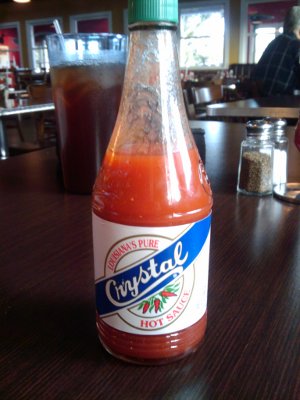A brief exchange at Starbucks:
Me: I’d like an iced chai, medium. I mean grande.
Barista: It’s OK, I speak both languages.
(At the hotel coffee shop during Westercon.)
A brief exchange at Starbucks:
Me: I’d like an iced chai, medium. I mean grande.
Barista: It’s OK, I speak both languages.
(At the hotel coffee shop during Westercon.)

A flier picked up at Sprouts, all about how to find the perfect drink to go with cheese. There’s a website, too: CheeseCupid.com lets you start with either a type of drink or a type of cheese, and find its perfect mate.
They even have an iPhone app. 😯
I guess the Cheese Information Center just wasn’t hitting the target.
Remember the Battlestar Galactica cake? For last night’s LOST finale, Katie made an authentic DHARMA Initiative chocolate cake, and pizzas with the Swan and Orchid logos.
The cake is chocolate, with homemade buttercream icing (vanilla for the background, chocolate for the design). The pizzas have an outer ring of sausage, with bell pepper strips for the I Ching. The Swan logo is cut from a bell pepper. The Orchid is cut from a tomato, and placed on the pizza after baking.
For more views, including in-progress pictures, close-ups, and making-of commentary, check out the LOST finale food photos on Flickr.
The latest seasonal beer at Oggi’s* is The Schwartz, a Belgian IPA. And just in case the “May the Schwartz Be With You” tagline wasn’t clear enough…well, check out the poster:

Sorry about the image quality. I wasn’t sampling the brew, it’s just the phone camera in low lighting.
*Oggi’s (pronounced OH-jeez) is a chain of pizza & brewery restaurants in Southern California, mostly in San Diego and Orange County.
Stopped for coffee on the way to Anaheim Comic Con. Yes, actually, I am wearing a Flash T-shirt. Why do you ask?
Even better, the rest of the convention center was taken up by a coffee convention! (For the uninitiated: There’s a running gag in the current Flash relaunch about how much coffee people drink in Central City…especially Iris Allen.)
Follow-up: read my full convention report and check out my photos.

 Now, I realize this is simply a brand name, probably inspired by the “pure” part of the slogan…but I can’t help but be reminded of the brief fad for clear products in the early 1990s. Remember Crystal Pepsi? Of course you don’t.
Now, I realize this is simply a brand name, probably inspired by the “pure” part of the slogan…but I can’t help but be reminded of the brief fad for clear products in the early 1990s. Remember Crystal Pepsi? Of course you don’t.
Saturday Night Live summed up just how unappetizing this fad really was in two words: Crystal Gravy.
Thankfully, Crystal Hot Sauce is not clear (as you can see!), and actually tasted pretty good.